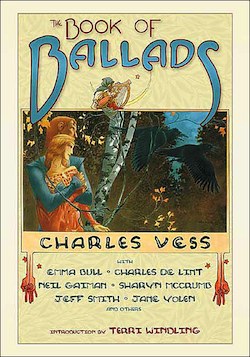The Book of Ballads is a collection, published by Tor in 2004, of the Charles Vess comics put out by Green Man Press in the nineties, plus a few new additions. Written by authors most commonly engaged with fairy tales and the mythic, from Neil Gaiman to Ellen Kushner to Emma Bull to Jane Yolen and onward, these comics put narratives to classic ballads—and then Charles Vess illustrates those narratives. It’s a gorgeous, thick book, at once scholarly and speculative, at once art and text, that has a direct connection to the classic ballads collected by folklore scholars and popularized in the last few centuries.
The introduction, written by Terri Windling—who certainly knows her way around a fairy tale or a ballad—is dense and quite chewy with scholarly detail and background on the ballads contained in the book, and also some that aren’t. The endpapers include a discography of performances of the ballads, by various artists and in various modes. These bookending documents lend an interstitial, genre-defying quality to The Book of Ballads that’s further increased by the intertextual nature of the ballads themselves.
The strangeness of The Book of Ballads is the best kind of strangeness: it seems to be many things at once, while still maintaining a balance that makes it cohere into a fully realized whole. The intertextual nature of translation between mediums—from oral ballads to written stories, from written stories to richly illustrated comics, and from those comics back to the oral, musical nature of the ballads via the ending discography—is a uniting force in the book, which transcends simple classification as a “graphic novel.” The comics are comics, but they are also these classic ballads collected and altered down the centuries, brought from obscurity back into vibrancy by the efforts of writers and artist.
The book is alive with history, re-imagined and brought back to the popular fore. The stories occasionally diverge from the ballads, adding motivational detail and character shape sometimes missing from the songs, or changing the setting like Charles de Lint’s modernized “Twa Corbies,” but the actual ballad is always included at the end of the story. Many of the ballads don’t need much “help” from the authors, other than translation into contemporary English prose; the story is already there, and already fantastic. Each authors’ contribution is gripping—hard not to be, with the source material they’re using—and the stories flow one to the other quite easily, without much need for a pause in-between. The similar themes that resonate throughout are the same themes that Windling discusses in her introduction on ballads—songs of joy, songs of sorrow, and songs of the supernatural.
There is a lean toward the supernatural in the ballads included here, likely because the contributors nearly all come from a speculative background, but it’s a workable and never dull lean. The fey, daemon lovers, curses, and all other sorts of magic abound in these ballads and their adaptations; only a few are simply songs of sorrow, like “The Three Lovers” (here rendered farcical and comedic in the frame of a play, by Lee Smith). The songs will be familiar to most fans of fantasy literature, even if by one remove—here we have both Tam-Lin and Thomas the Rhymer, both subjects of quite a lot of novels in the genre.
However, the real gift of The Book of Ballads is not the writers’ scripting of these ballads into stories, but Charles Vess’s illustrations of those stories/songs. Vess’s iconic style is perfectly suited to this subject material. The comics are all illustrated in inks; thick, evocative lines of black on white on grey capture the wildness and the magic of the stories, while the lighter lines provide subtler shadings of emotion on the characters’ bodies and faces. The style of the Tam-Lin comic by Elaine Lee is a narrative counterpointed with single still images, paintings in ink, that bring to life key scenes in her version of the ballad—while the narrative chunks are framed by an image of the tattooed and flower-crowned woman from the story’s opening. Others are more in the usual graphic novel style, shifting from panel to panel to tell stories.
All of them are beautiful.
Charles Vess was the perfect artist to undertake this project of bringing visual life to the oral tales, and the writers chosen to do the story-making fit just as well. The Book of Ballads is a case of the perfect combination of factors: all of the pieces come together just so to make a genuinely handsome, engaging, and moving collection that hearkens back to a past that is at once immediate and real, but also unmoored in time. Reading The Book of Ballads is a pleasure that’s nerdy and speculative and historical and just damned pretty all at the same time; I’m glad I found a copy, and wish I’d seen it earlier. Kudos to Green Man Press for publishing the original single comics, and to Tor for collecting, expanding, and republishing them.
Lee Mandelo is a multi-fandom geek with a special love for comics and queer literature. She can be found on Twitter and Livejournal.










